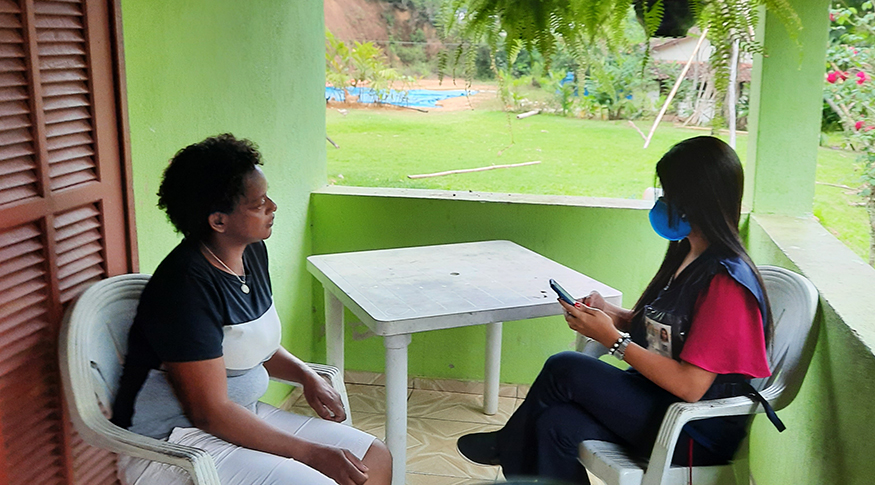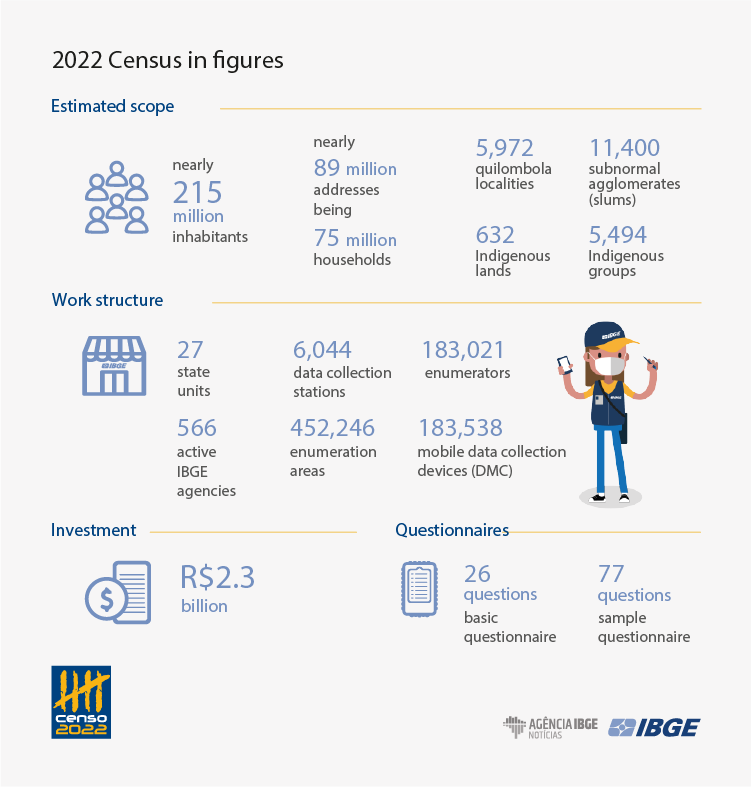2022 Census
2022 Census begins today in entire country, enumerators will visit 75 million households
August 01, 2022 09h00 AM | Last Updated: August 17, 2022 10h38 AM
Highlights
- The 2022 Population Census begins to be collected today in the 5,570 Brazilian municipalities. The IBGE enumerators will visit 89 million addresses, being 75 million households. Nearly 215 million people are expected to be counted.
- Altogether, they are 452,246 urban and rural enumeration areas, 5,972 quilombola localities, 624 indigenous lands, 11,400 subnormal agglomerates and 5,778 indigenous groups. The operation will cost R$2.3 billion.
- Two types of questionnaire will be applied: the basic one, with 26 questions, takes nearly 5 minutes to be answered. The improved questionnaire, with 77 questions ans answered by nearly 11% of the households, takes nearly 16 minutes.
- Questionnaires can be answered face-to-face, by telephone or through the Internet. Agents from the Census Support Center (0800 721 8181) will answer doubts, will provide conceptual and operational support when filling the questionnaire through the Internet and, once authorized, they might fill the questionnaire in an interview.
- Enumerators will always use a uniform, including the IBGE vest, Census cap, identification badge and the Mobile Data Collection Device (DMC). The identity of the IBGE agent can be confirmed on the Responding the IBGE website (respondendo.ibge.gov.br) or through telephone 0800 721 8181.
- More than 15 thousand positions for enumerator are open until August 3.

The IBGE begins today (1) the household data collection of the 2022 Population Census with a launching ceremony in the Museum of Tomorrow, in Rio de Janeiro. Over the next three months, IBGE enumerators will visit 89 million addresses, being 75 million households. Nearly 215 million people are expected to be counted.
The Brazilian Census is one of the largest census operations in the world. In the peak of the operation, nearly 183 thousand enumerators will knock every door in all the 5,570 Brazilian municipalities. Altogether, they are 452,246 urban and rural enumeration areas, 5,972 quilombola localities, 632 indigenous lands, 11,400 subnormal agglomerates and 5,494 indigenous groups.
“The Census does not belong to the IBGE, it belongs to Brazil and it is for Brazil. The Census belongs to all of us. Our team will visit every Brazilian home, collecting information that will be very relevant to the future of Brazil. We will not leave anyone behind, and for this we count with the support of the Brazilian citizens. Please welcome the IBGE!,” summons President Eduardo Rios Neto.
Initially scheduled for 2020, yet postponed due to the pandemic and in 2021 due to budget issues, the 2022 Census marks 150 years of the first census carried out in Brazil.
“The first Census was carried out in 1872 to count the outcome of the Paraguay War, reaching nearly 10 million people. 150 years later, we are challenged to count 215 million people, according to the population estimates,” comments Cimar Azeredo, IBGE´s Director of Surveys.
He explains that, besides identifying the population by sex and age, the Census brings a robust questionnaire, strictly following the recommendations of the United Nations. “The United Nations has a set of questions recommended to every country. We are following that and also adding information that is important to follow up the Brazilian reality.”
Azeredo highlights that this is the first Census completely digital, from data collection to data transmission, follow up, storage and processing. “The information is completely protected,” assures him.
According to Claudio Stenner, IBGE´s Director of Geosciences, the Census is a true celebration of the integration between statistical and geographic information. “Only in the Census we can articulate the three scales of characteristics: of the surroundings where the households are located, of the households themselves and of the people who live in these households. Actually, it is the only survey in which we can show the different situations existing in the cities and provide a more complete and integrated scenario of the Brazilian territory and its population,” assesses him.
It is worth reminding that the Survey of Surroundings precedes the household data collection and it is completed.

Basic questionnaire takes 5 minutes to be answered
The 2022 Census involves two types of questionnaire: the basic one, with 26 questions, that takes nearly 5 minutes to be responded. On the other hand, the enhanced questionnaire includes 77 questions, will be responded by nearly 11% of the households and takes nearly 16 minutes. The selection of the sample that will answer the enhanced questionnaire is random and automatically performed by the enumerator´s Mobile Data Collection Device (DMC).
“This is the median response time, i.e., half of the households take less than 5 or 16 minutes, depending on the questionnaire, and half of them take more than that. It is mainly due to the number of residents in the household,” explains Luciano Duarte, the person in charge of the technical design of the 2022 Census.
The basic questionnaire brings the following blocks of questions: identification of the household, information on residents, characteristics of the household, ethnic-racial identification, civil status, education, earnings of the person in charge of the household, mortality. Besides the blocks contained in the basic questionnaire, the sample questionnaire also investigates: labor, earnings, nuptiality, family core, fertility, religion or cult, persons with disability, domestic and international migration, commuting for study, commuting for work and autism.
In addition, the IBGE requests the data of the person who provided the information, like name, telephone, email and CPF. “The CPF helps us to improve the quality of the coverage of the operation,” clarifies Duarte. Any resident, above 12 years, able to provide information, can respond to the enumerators on behalf of the other residents in that household. In other words, only one person of the household will respond on behalf of every resident.
All the information collected is confidential, protected by secrecy and exclusively used for statistical purposes, according to the following legislation: Law no. 5,534/68, Law no. 5,878/73 and Decree no. 73,177/73. On the other hand, Law no. 5,534, of November 14, 1968, establishes the enforcement of providing statistical information.
Questionnaire can be answered face-to-face, by telephone or through the Internet
Besides the face-to-face data collection and filling through the Internet, the Census can also be answered by telephone. “Anyway, enumerators should visit the households to capture the coordinates and contact the residents,” explains Duarte.
From this point on, citizens might carry out or schedule the face-to-face interviews, appoint an interview by telephone or fill the questionnaire through the Internet. If they decide to answer it through the Internet, the informants will receive an eticket valid for seven days.
The interview through telephone will also be used by those who decide to fill the questionnaire through the Internet, but do not complete it. To do this, the IBGE will have an exclusive switchboard, the Census Support Center (CAC), available on 0800 721 8181.
The CAC agents will clear general doubts about the Census, will provide conceptual and operational support to fill the questionnaires through the Internet and, if approved by the resident, they might fill the questionnaires in an interview. That authorization is granted through a password, sent through either email or SMS, allowing the IBGE agent to fill the questionnaires.
In case of refusals or absence of residents, the IBGE has a contingency strategy. If the enumerators do not find the residents in the first visit, they will leave a message and/or try to contact them by telephone, whenever that information is in the DMC. In addition, the enumerators should return to the households four more times at least, one of them in an alternative shift.
“This is automatically monitored by the system, which follows up the routes tracked by the enumerators. Only after returning four times they can ‘withdraw’ from those households,” explains Duarte.
After completing the data collection in their enumeration areas, their supervisors will return to the households with absent residents or express refusal and will leave a notification letter containing an eticket valid for ten days to fill the questionnaires through the Internet. “This is the last attempt and, if there is not any answer, they will not return and the households will be statistically treated later,” concludes the technical designer of the Census.
Enumerators will use uniform and can be identified through the Internet or telephone
In addition to be approved in the selection process, IBGE enumerators should participate in a specific training including on-site and off-site steps. Only after being approved in the training, the enumerators are able to fulfill their mission of visiting the Brazilian homes.
They will always use a uniform, including the IBGE vest, Census cap, identification badge and the DMC. It is also possible to confirm the identity of the IBGE agent on the Responding to the IBGE website or through telephone 0800 7218181. Both of them are included in the interviewer´s badge, which also brings a QR code that provides the identification on the website. To confirm it, citizens should provide the enumerator´s name, registration or CPF.
Some partnerships were signed between the IBGE, associations of administrators or real estate and condominiums, as well as with housing unions. It aims at disseminating information and guidelines to residents, administrators, porters and janitors, guaranteeing the integrity of both the residents to be visited and the IBGE enumerators.





















